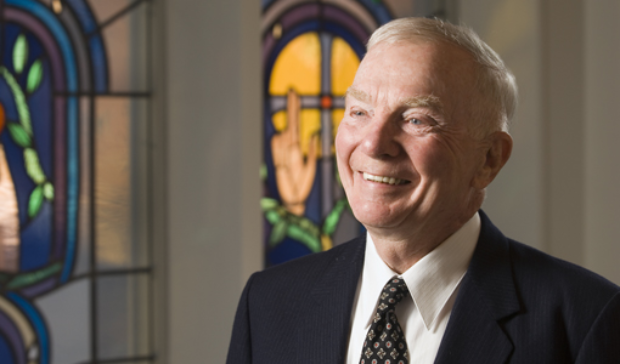Now that I am retiring after working at St. Thomas for 24 years, I have - as always - a few things to say.
I've been around - working on Wall Street in New York and in Europe, teaching college English in three states, and lucky enough to meet John F. Kennedy, Martin Luther King Jr. and Stan "The Man" Musial - so I thought St. Thomas was a nice college but not exceptional.
True, I was a little disenchanted about the "nice" when my husband, John (a 1964 alumnus and academic dean at UST from 1981 until his death in 1993), and our 10-year-old son came home laughing from a St. Thomas-St. John's basketball game. They explained that St. Thomas students unrolled life-size posters of bathing beauties under the basket every time a St. John's player was shooting free throws. "Rather sexist," I commented. "But St. Thomas won," my son said. "I'm going to college there. It looks like fun."
When he and his sisters did attend St. Thomas, I discovered there was more to this university than meets the eye. It is far more than "nice." The reason is the amazing generosity of faculty and staff interaction with students.
A freshman I once interviewed said she had turned down a scholarship to the University of Minnesota because of the UST quadrangle. "Huh?" I said. "The buildings and grounds here are beautiful," she explained. "I figure if St. Thomas takes good care of its exterior, it must take great care of its students."
That's true. Though - interestingly enough - I never actually met my children walking across campus, I did hear a great deal about how classes were going for them and their friends. My children were not given unusual treatment. They simply were studying in a very stimulating and concerned environment.
They sat in music education classes and obeyed directions to look out at the sunset while listening to Bach; they sometimes composed their own music as part of the final exam. They played softball or basketball after classes with funny and trash-talking teachers who thought the college experience had to include fun with professors. They toured modern art galleries and went to experimental plays - which sometimes they even liked.
Students graduated because faculty and staff lent them books, tutored them, encouraged them, comforted them in hard times, made them discuss the issues of life in classes from English to history to geology, encouraged them to volunteer and forced them to work hard. About 80 percent of all St. Thomas students say they interact with faculty outside of classes, one of the things they enjoy most in college. Of course, a few faculty, staff and students are not so admirable, but I am always surprised how few there are.
Faculty and staff have been generous in writing for the St. Thomas magazine and are one of the main reasons for its success. They wrote about expanding student horizons - taking classes to Northern Ireland to explore social justice, to Rome to study ancient engineering, and to Ascension Parish in Minneapolis to evaluate immigrant neighborhoods. They brought Holocaust survivors to campus and explained why Shakespeare endures.
And they are interesting subjects. No one fits "different" better than Dr. Paul Alper and Dr. Bob Raymond in the Winter 1996 story, "Statistics Professors Get Lots of Mileage from Students' Nix of Nike." Laughing at the connection between college coaches and big bucks, their sardonic premise was why couldn't college teachers become "sole models" by getting paid to wear Nikes to class? The only nonathletes to get a shoe deal from Nike were covered nationally on TV and by papers such as The Wall Street Journal. But all they got were free shoes.
The experiment flopped, but Raymond discovered fewer students were wearing Nikes at the end of the semester than when it began. "I think I'm on to something," he said enthusiastically. "If we could prove that we hurt the sale of Nikes, I could get paid for not wearing Nikes, Adidas, any brand really."
Students are memorable, too. Once I wrote a story about the search for the typical UST student and found a senior who delivered the mail and hung out with "regular people who work a lot and go to school. With one friend, if we go out, we only have one beer because he has no money to spare." There was the young woman who graduated at age 19, the preppy student with dyslexia who appreciated the help given him in the Enhancement Program, the ballerina from Juilliard getting a teaching degree, the retired farmer and senior citizen with two majors, and the Puerto Rican native who started night school part time and finished by winning a theology fellowship to Harvard. Finally, I stopped looking for "typical." There is more to UST students, too, than meets the eye.
I know students who have traveled all over Europe and South America as well as to China and Cuba, a necessity since - let's face it - the Twin Cities do tend to be a little chilly. I'm not from Minnesota, so the usual "Well, at least the sun is shining even though it's zero out" just annoys me. I feel like Ulysses S. Grant, who, commenting on what must have been weather similar to that in Minnesota, said in 1880: "The Pilgrim Fathers fell upon an ungenial climate, where there were nine months of winter and three months of cold weather."
So I'm moving south. But despite my dislike for a cold climate, I'll always have a warm spot for St. Thomas. There is much more to this university than meets the eye.




